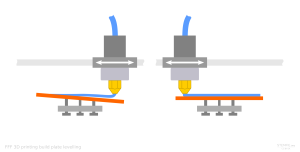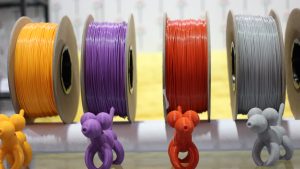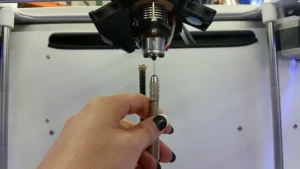The best way to ensure the longevity of your 3D printer is through regular preventative maintenance. The goal of preventative maintenance is to identify potential problems before they become real issues that may eventually cause damage to your printer or affect the quality of your prints. Here are some steps you should take semi-regularly to maintain your printer:
- Clean the Build Plate: The build plate is where your 3D prints come to life. Over time, residue can accumulate on the surface, which can affect the quality of your prints and may even cause them to fail. Dust, grime, and even the oils present in our fingertips can disrupt plastic adhesion. For glass beds, cleaning with isopropyl alcohol (IPA) is recommended. If you’re using glue sticks, make sure to clean off any residue regularly to prevent a build-up. And if you’re using adhesive tapes or special stickers, inspecting them for damage and replacing them when necessary is very important.
 Level the Bed: Adequate bed levelling is essential for the proper adhesion of your prints. Even with auto-levelling, featured on most modern printers, it’s a good idea to manually check and adjust the level of the bed every now and then. This is especially important when printing with materials that have high thermal contraction, such as nylon or PC. Using a piece of paper to check the distance between the nozzle and the bed at various points can be an effective method of ensuring a level bed.
Level the Bed: Adequate bed levelling is essential for the proper adhesion of your prints. Even with auto-levelling, featured on most modern printers, it’s a good idea to manually check and adjust the level of the bed every now and then. This is especially important when printing with materials that have high thermal contraction, such as nylon or PC. Using a piece of paper to check the distance between the nozzle and the bed at various points can be an effective method of ensuring a level bed.- Check the Filament: The filament itself can accumulate dust and small particles over time, especially if not stored properly. These can cause issues with your prints, and can even clog the nozzle in extreme cases. It’s a good idea, then, to store your filaments in a cool, dry place to prevent dust accumulation and moisture absorption. If you’re noticing consistent dust build-up on your filament, consider using a filament filter or dust filter. These are often DIY solutions that can be downloaded from sites like Thingiverse and printed on your own 3D printer!

- Lubricate Moving Parts: The moving parts of your printer, such as the rods, bearings, and lead screws, should be lubricated regularly to ensure they continue to operate smoothly. Use a high-quality, non-greasy lubricant, but be sure to apply it sparingly – too much lubricant can be detrimental if it attracts too much dust and other particles, which can cause wear and tear over time.
- Inspect the Nozzle: The nozzle is one of the most crucial parts of your 3D printer and should be inspected regularly for signs of wear or blockages. If you notice any problems, clean it with a wire brush or replace it if necessary. Remember that nozzles often get hot, so use caution when inspecting and handling them.

- Calibrate the Printer: After performing the preventative maintenance tasks, it’s important to calibrate the printer. This involves checking and adjusting the steps per millimetre of the extruder, aligning the print bed, and testing the accuracy of the temperature readings. Calibration is best done with a simple print, such as an XYZ calibration cube, that will highlight any issues in your printer’s performance.
Preventative maintenance might seem like a chore, but it’s a small price to pay for the extended lifespan and improved performance of your 3D printer. With regular check-ups, you’ll be able to spot potential issues before they cause problems, saving you valuable time and money.




